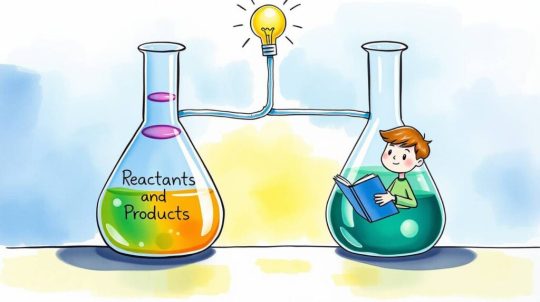#lechatelierprinciplebasics
Explore tagged Tumblr posts
Text
Why do chemical reactions reach equilibrium?

You’re here — which means you probably already have the textbook open somewhere, and it's not making sense. So forget the hard definitions and let’s break this down like we’re just talking it out with a friend over chai or iced coffee ☕💬
Why Do Chemical Reactions Reach Equilibrium?
Alright, picture this: You’ve got a water slide with kids climbing up on one side and sliding down on the other. At first, the kids are all climbing up (the forward reaction), and nobody’s sliding down yet (the reverse reaction). But after a while, enough kids get to the top, and some start sliding down. Eventually, for every kid that climbs up, another one slides down. That moment when the number of kids going up equals the number coming down? That’s chemical equilibrium. 🎯 Let’s unpack this properly 👇 🧪 So, What Even Is a Chemical Reaction? When two or more substances mix and rearrange their atoms to make new substances, that’s a chemical reaction. Some go all the way forward and finish (like burning paper — you’re not un-burning that, bro), but others? They’re reversible. Reversible reactions are like tug-of-war: the reactants turn into products, and then the products can also turn back into reactants. — ⚖️ What Is Equilibrium, Really? Equilibrium is not some frozen, perfectly balanced moment where nothing happens. Nah — it’s more like a silent agreement: “Okay, I’ll turn into you, and you turn back into me. Let’s just keep swapping, but keep the balance.” It’s a state where the forward reaction and the reverse reaction happen at the exact same rate. So even though molecules are still reacting, the overall amounts of reactants and products stay constant. Not equal — just constant. It’s like a dance. Everyone’s moving, but the positions on the dance floor don’t change much. 💃🕺 —




🔁 Why Do Reactions Even Try to Reach Equilibrium? Because nature’s lazy. Okay, not lazy — just efficient. The universe is always trying to find a chill, low-energy, balanced state. That's its vibe. When a chemical reaction starts, the reactants go nuts making products. But soon enough, the concentration of products gets high enough that they start reversing back into reactants. The system keeps adjusting until there’s no more net change. That point? The reaction’s like, “Cool. I’m good here.” And that’s equilibrium. — 🔥 Does It Mean The Reaction Is Done? Nope! That’s the twist. At equilibrium, the reaction isn’t “over” — it’s still happening on both sides. You just don’t see any big changes because everything is happening equally in both directions. It’s like filling a cup while draining it at the same speed. Water keeps flowing — but the level stays the same. — 🧠 Real Life Example? Ammonia production (used for fertilizers) is a classic one. The Haber process balances nitrogen and hydrogen to make ammonia. The trick? Engineers tweak pressure and temperature to shift equilibrium and make more ammonia. Also, your own body’s breathing process — the balance between carbon dioxide and carbonic acid in your blood — is all thanks to equilibrium. So yeah, this isn’t just school stuff. Your life literally runs on this. — 🔄 Can We Shift the Equilibrium? Absolutely. Shoutout to Le Chatelier’s Principle (yes, it’s French and sounds dramatic 🇫🇷). It basically says: “If you mess with my vibe (by changing temperature, pressure, or concentration), I’ll adjust to get it back.” So adding more reactants? The system makes more products. Increase the temperature? The system shifts to cool down. It’s like your brain adjusting when someone steals your last fry — dramatic, but it reacts. — 💡 Summary Vibes: - Reactions reach equilibrium to balance forward and reverse reactions. - At equilibrium, the reaction doesn’t stop — it just chills at a steady pace. - Nature loves balance. Chemistry just follows that rulebook. So next time someone says “balanced reaction,” just picture a tug-of-war where both sides finally go, “Bro, let’s stop pulling and just hang here.” — 📌 Disclaimer: This easy version is meant to help you understand the concept better. If your exam or teacher expects a textbook explanation and you write this one instead, we’re not responsible if it affects your marks. Use this for understanding, not copy-pasting. — 🔗 Related Articles from EdgyThoughts.com: Why Do Electrons Occupy Orbitals in Specific Order 2025 https://edgythoughts.com/why-do-electrons-occupy-orbitals-in-specific-order-2025 Why Does Hybridization Occur in Chemical Bonding 2025 https://edgythoughts.com/why-does-hybridization-occur-in-chemical-bonding-2025 🌐 External Resource: Curious about how equilibrium applies in real-world chemistry? Check out: https://en.wikipedia.org/wiki/Chemical_equilibrium Read the full article
#chemicalchangessimplified#chemicalequilibriumexplained#chemicalreactionsbalance#chemistryequilibrium2025#chemistryforbeginners#chemistryhelpforschool#dynamicequilibriummeaning#equilibriumreactionsimple#equilibriumreactionsfunexplanation#equilibriumvscompletion#howreactionsstabilize#lechatelierprinciplebasics#learnchemistryconceptseasily#reactionbalanceconcept#reversiblereactionsexplained#scienceblogforstudents#studentfriendlychemistryblog#whatischemicalequilibrium#whyreactionsreachequilibrium
0 notes